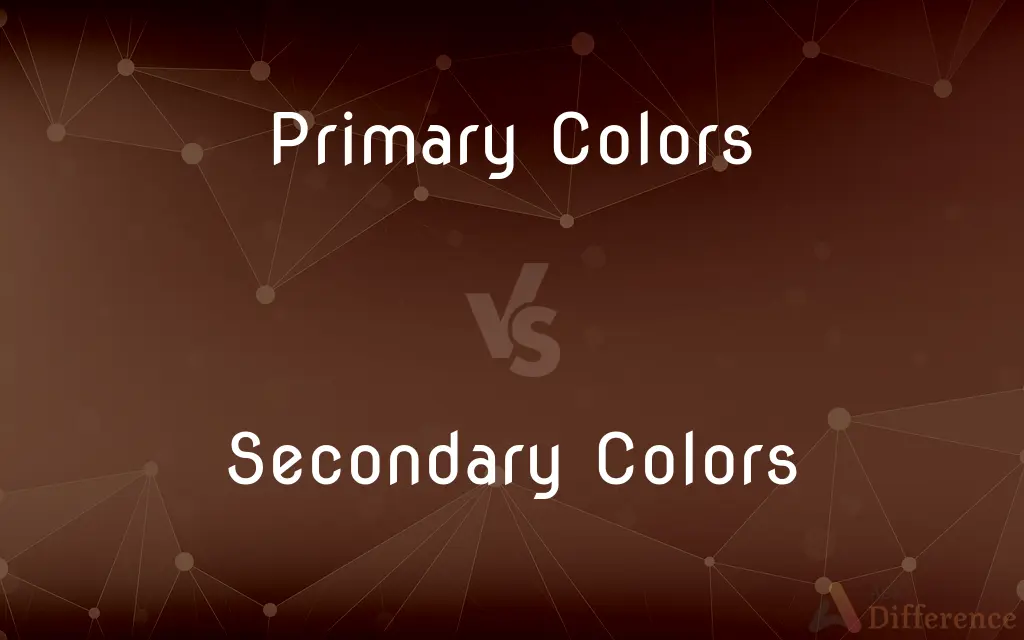Primary Colors vs. Secondary Colors — What's the Difference?
By Tayyaba Rehman — Published on December 29, 2023
Primary colors are the base colors, while secondary colors are formed by mixing two primary colors.

Difference Between Primary Colors and Secondary Colors
Table of Contents
ADVERTISEMENT
Key Differences
Primary colors are the foundation of all other hues and cannot be created by mixing any other colors together. They are the essential starting points in the color spectrum. In contrast, secondary colors emerge when two primary colors are combined in equal measure. Therefore, while primary colors are inherent and exist without the need for combination, secondary colors owe their existence to the blending of primary colors.
In the realm of pigment (like in painting), the primary colors are traditionally recognized as red, blue, and yellow. When an artist desires to achieve a broader spectrum of colors, they turn to mixing these primary shades. The result of such mixtures leads to the creation of secondary colors: green (from blue and yellow), orange (from red and yellow), and purple (from blue and red).
Primary colors act as the backbone in the world of color theory. They are unique because no combination of other colors will produce them. On the other hand, secondary colors play a crucial role in enhancing and diversifying the color palette. By understanding the relationship between primary and secondary colors, one can predict the outcome of color mixtures and create a myriad of shades and tones.
It's fascinating to think that the vast spectrum of colors we see around us begins with just three primary colors. Without these foundational hues, the secondary colors would not exist. While primary colors remain constant and unchangeable, secondary colors are a testament to the variety and richness that can be achieved through combination.
In both art and science, the distinction between primary and secondary colors is fundamental. Primary colors, in their purest form, stand alone and serve as the pillars of color creation. Secondary colors, however, are the harmonious products that emerge from the union of two primary colors, showcasing the versatility and depth possible in the world of color.
ADVERTISEMENT
Comparison Chart
Origin
Base colors not derived from mixing.
Created by mixing two primary colors.
Examples (Traditional)
Red, Yellow, Blue
Green, Orange, Purple
Examples (RGB)
Red, Green, Blue
Cyan, Magenta, Yellow
Achieved by mixing
Cannot be made by mixing other colors.
Result from blending two primary colors.
Position on color wheel
Fundamental colors around which the wheel is based.
Positioned between primary colors on the wheel.
Compare with Definitions
Primary Colors
Cannot be derived by combining other colors.
Blue is a primary color and cannot be made by mixing other hues.
Secondary Colors
Enhance the diversity of the color spectrum.
Secondary colors like orange enrich artistic palettes.
Primary Colors
Base colors not formed from mixing others.
Red is a primary color.
Secondary Colors
Colors formed by mixing two primary colors.
Orange is a secondary color resulting from red and yellow.
Primary Colors
Fundamental hues in the color wheel.
Yellow, as a primary color, stands distinct in the color spectrum.
Secondary Colors
Direct outcome of primary color blending.
Cyan emerges when the primary colors blue and green merge.
Primary Colors
Origin of all other colors in the spectrum.
Green emerges from the primary colors blue and yellow.
Secondary Colors
Bridge hues between primary colors on a color wheel.
Green, a secondary color, lies between blue and yellow.
Primary Colors
Essential palette colors in art and design.
Primary colors like red are indispensable in art creation.
Secondary Colors
Derived and not fundamental colors.
Purple is a secondary color, formed by mixing red and blue.
Common Curiosities
Which colors combine to create secondary colors?
Two primary colors mix to produce secondary colors.
What are secondary colors?
Secondary colors result from the combination of two primary colors.
What are the primary colors in the traditional color model?
In the traditional color model, the primary colors are red, yellow, and blue.
What are primary colors?
Primary colors are the base colors from which other colors are derived and cannot be formed by mixing other colors.
Are secondary colors as basic as primary colors?
No, secondary colors are derived, while primary colors are fundamental.
Can primary colors be created by mixing other colors?
No, primary colors cannot be achieved by mixing other colors.
How many primary colors are there?
There are three primary colors.
How many secondary colors are there?
There are three secondary colors.
Are primary colors more important than secondary colors?
Both primary and secondary colors have their significance; primary colors are foundational, while secondary colors enrich the spectrum.
What are the secondary colors in the RGB model?
In the RGB model, the secondary colors are cyan, magenta, and yellow.
In digital media, what are the primary colors?
In digital media, the primary colors are red, green, and blue (RGB).
Which primary colors make the secondary color green?
The primary colors blue and yellow combine to create green.
Can secondary colors create primary colors when mixed?
No, mixing secondary colors will not produce primary colors.
Do different cultures view primary and secondary colors similarly?
While the science of colors remains constant, cultural interpretations and significances of primary and secondary colors can vary.
What happens when all primary colors are mixed?
In light, mixing all primary colors produces white. In pigment, it often results in a muddy brown or gray.
Share Your Discovery

Previous Comparison
Oat Bran vs. Oatmeal
Next Comparison
Object Oriented Database vs. Object Relational DatabaseAuthor Spotlight
Written by
Tayyaba RehmanTayyaba Rehman is a distinguished writer, currently serving as a primary contributor to askdifference.com. As a researcher in semantics and etymology, Tayyaba's passion for the complexity of languages and their distinctions has found a perfect home on the platform. Tayyaba delves into the intricacies of language, distinguishing between commonly confused words and phrases, thereby providing clarity for readers worldwide.












































